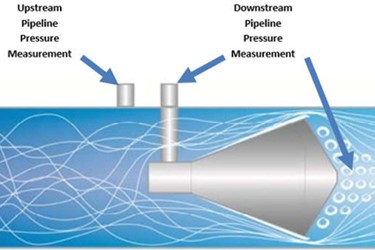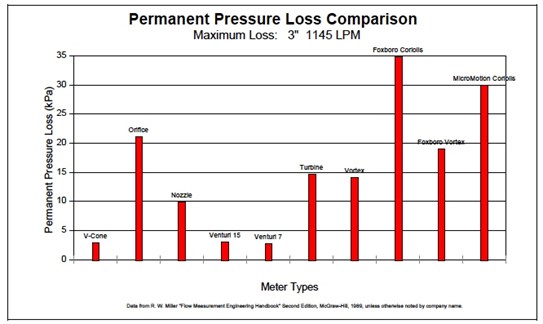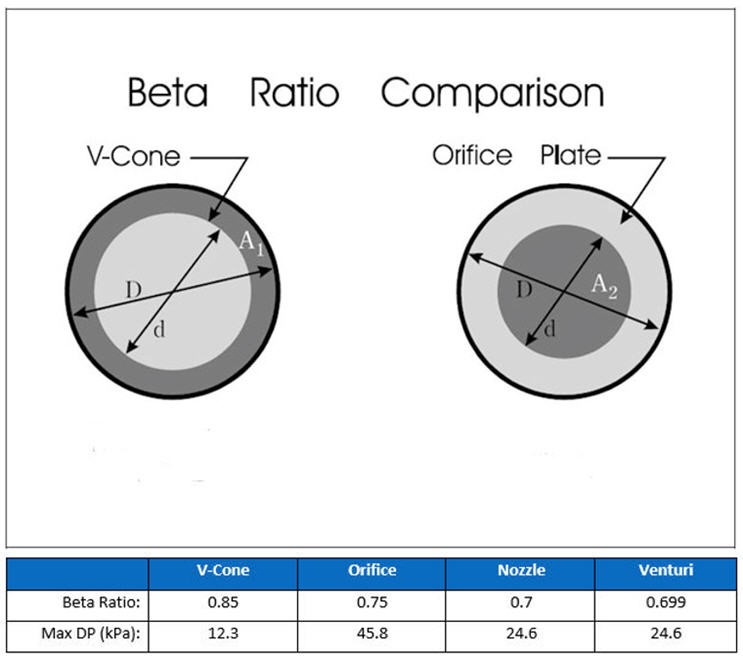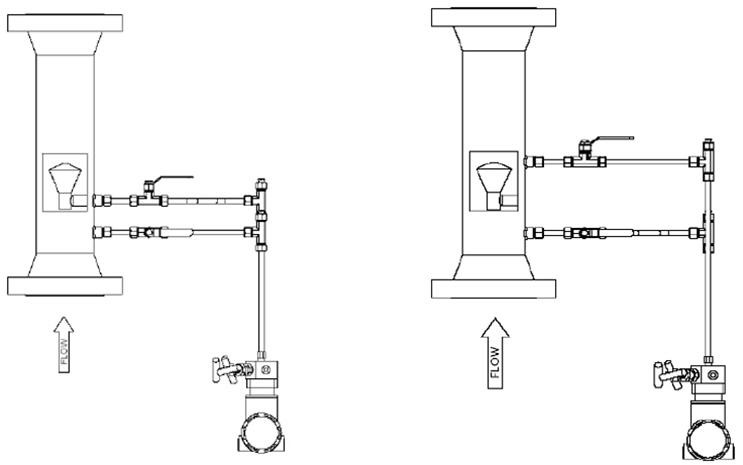- PRODUCTS
- INDUSTRIES
- RESOURCES
- SUPPORT
What Is A V-Cone Meter? And Why Should I Care?

There is a better alternative for differential pressure (DP) metering accuracy in problematic applications where other meter designs might compromise performance. A V-Cone meter’s simple mechanical design overcomes confined spacing, pipeline turbulence, and even noisy electrical environments that can hamper other meters. Best of all, it delivers + 0.5 percent accuracy and provides an easy retrofit solution for difficult installations.
What is a V-Cone meter and how does it work?
A V-Cone meter uses an advanced flow-sensing design, which is different from other DP meters. In addition to its highly accurate readings, the V-Cone is designed to cope with a number of challenges experienced in municipal and industrial water and wastewater measurement applications:
- Tight Spacing. V-Cone operation allows for more compact new designs and fits easily into most retrofit applications because it can be installed in close proximity to elbows, valves, pumps, chemical injectors, and other structures that might hamper other flow measurement technologies.
- Turbulence. Built-in flow conditioning technology minimizes straight pipe length requirements demanded by other types of meters.
- Electronic Noise. The mechanical design of the V-Cone eliminates problems of noise or interference in electrically dense environments.
- Variable Water Quality. Special V-Cone designs avoid the repetitive clogging experienced by mag meters in dirty water applications.
Why is the V-Cone design not more widely used for its physical performance advantages?
Some people who hear “differential-pressure meter” associate it with other, more limiting DP meter designs — such as those relying on orifice plates, which can induce more turbulence and permanent pressure loss. Because a V-Cone meter creates a smoother flow and operates at a lower differential pressure than other DP meters, it experiences low permanent pressure loss and reduces energy costs for pumping (Figure 1).
The best decision-making criteria for any metering technology — DP or otherwise — come from analyzing the total cost of ownership over the life of the meter. By comparing purchase cost, installation cost, ancillary piping design costs, maintenance impacts, and associated downtime costs, plus the longevity of the meter in the end-use application, a system designer or user can calculate the true value of each meter style. By that evaluation, V-Cone meters often provide a more cost-effective solution across a variety of applications.

Figure 1. V-Cone meters exhibit low permanent pressure loss as compared to other types of meters — including orifice and nozzle DP meters.
How does a V-Cone meter differ from other DP meters?
A big factor in V-Cone accuracy is in how it creates and measures differential pressure in a way that does not compromise other performance factors. This is the most important factor for piping designers to appreciate.
All DP meters calculate the volume of flow relative to the pipeline pressure before and after a change in the cross-section of the flow, based on Bernoulli’s theorem for conservation of energy in a closed pipe (i.e., velocity and pressure vary inversely according to the rate of fluid flowing through the pipe). Other types of DP meters, however — such as orifice plates, vortex meters, and Venturi meters — use a smaller opening, create more turbulence, and use a differential pressure that is at least twice as high as a V-Cone meter. That is why they generate a higher permanent pressure loss, put more stress on pumps, and require higher energy costs (Figure 2).
By contrast, a V-Cone meter is inherently less disruptive than other DP meter designs because the flow-conditioning aspects of its cone create a stable flow profile that complements the flow sensing design and increases accuracy. Unlike an orifice plate that presents an abrupt stop of flow around the inner surface of the pipe to create its upstream vs. downstream pressure differential, the V-Cone shape centrally positioned within the pipe gently reshapes the flow profile symmetrically around the pipe’s interior surface. This creates a smoother transition and results in a more stable signal that improves the accuracy of its readings. This video comparison shows how a V-Cone meter also creates a smoother flow through a pipeline.

Figures 2A and 2B. V-Cone meters provide a greater opening (beta ratio) in the cross-section of the pipe and use a lower pressure differential than other types of DP meters to deliver more favorable performance characteristics.
Where has the V-Cone meter design proved its value in industrial and commercial applications?
Due to its simplified mechanical design, no moving parts, and no need for electrical power to take measurements, plus a high degree of flexibility in the fluids it can measure, the V-Cone meter design has experienced wide-ranging acceptance in the oil, natural gas, and refinery marketplace.
Its ability to measure air, gas, steam, oil, water, and other fluids accurately provides advantages over multiple types of meters — including DP meters, mag meters, and others. Multiple formats of the basic V-Cone design are available in a variety of physical executions, designed to meet the space, configuration, and chemical environments in which they are used. Corrosion-resistant versions are also available for use with harsh fluids or in harsh environments.
What are some of the best-suited applications for V-Cone meters in municipal and industrial water and wastewater applications?
V-Cone meters are well suited to a wide range of municipal and industrial water applications — well water production, raw water influent, pipe headers and filter galleries, finished water effluent, pump stations, cooling water, reclaimed water, and other water collection/distribution applications. While they are designed primarily for clean water flow, they can tolerate modest amounts of sand, minerals, or minor biological solids entrained in the flow.
With its mechanical design, can a V-Cone meter be part of a digital data collection and management system?
Yes, V-Cone meters use a differential pressure transmitter to measure and convert the differential pressure signal from the primary element to an electronic signal that can be interpreted by a flow monitor or process control system. HART, Modbus, Profibus, and Fieldbus communication protocols are available.
What advantage does a V-Cone meter offer for new and retrofit applications?
Installation spacing is a particular advantage, because V-Cone meter accuracy is unaffected by turbulent pipeline flows where other meter designs would require long runs of straight piping. Other types of meters can require from 10 to 20 diameters of straight pipe between them and a valve, elbow, or other pipeline components to assure accurate readings. In new piping configurations, those straight-run requirements can translate into significantly higher pipe expenses and greater space demands.
Whether a user is replacing an existing meter or adding a V-Cone meter to an installation that did not previously have a meter, the V-Cone adapts well to existing pipelines with tight spacing, turns, and other turbulence-inducing structures. Also, because a V-Cone meter can be made in custom lay lengths, it is an easy swap-out replacement for existing flange-mounted mechanical or electronic meters.
What types of applications are better suited to a V-Cone design rather than a mag meter?
There are several plant environments that the V-Cone mechanical design with no moving parts accommodates better than an electromagnetic meter. One environment would be in electrically charged areas, which can disrupt the electromagnetic sensing of mag meter performance. This can occur in areas around a pump array or other circumstances where there might be excess electrical noise in the pipeline or in the external environment that could cause erratic flow measurements. As a pressure-related mechanical solution, V-Cone performance is not compromised by such electrically dense environments. A second environment is in raw water intakes or wastewater effluent with turbidity or entrained solids that can foul electromagnetic sensors.
Why can a V-Cone meter be a better solution than a mag meter for dirty water or water with entrained solids?
A V-Cone with a wall-tap design made especially for dirtier water provides a better option than a mag meter whose readings could be compromised if its sensors become coated with debris. The difference in V-Cone performance can translate into significant savings in downtime and labor expense relative to removing and cleaning fouled mag meter sensors.
For dirty water applications, it is important to incorporate the correct V-Cone model and to mount it correctly to take advantage of its low-maintenance performance and operational accuracy. For example, on any V-Cone differential pressure meter, the high-pressure reading is always taken through the wall of the pipe upstream of the V-Cone insert. Normally, the low-pressure reading is taken through the hollow body of the cone itself. In cases with dirty water or entrained solids, the cone is sealed and the low-pressure reading is taken through a wall-tap in the pipe after the flow passes the cone (Figure 3). This allows the meter to read the differential pressure without risking a clog within the hollow cone itself.

Figures 3A and 3B. For clean water applications (left), the V-Cone meter measures the pressure differential between the pipeline before the cone and the interior of the hollow cone with an open port on its downstream side. To prevent potential clogging of the cone port in dirty water applications (right), the V-Cone meter uses a sealed cone and measures the pressure differential between the pipeline in advance of the cone and the pipeline just after the cone.
What does the “V” in V-Cone represent?
The “V” in V-Cone simply represents the shape of the cone. It does not stand for Venturi (Venturi-Cone). Although the underlying technology of V-Cone measurement is based on the same principles of Bernoulli’s theorem for measurement, as a Venturi meter is, the similarities end there.

